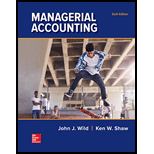
Concept explainers
Equity Accounts: Equity Account comprises of items relating to the owner’s of the business. They include the common stock,
Liability: Liabilities represent the amount which the business owes to outsiders. Examples of liabilities include bank loans, notes payable, accounts payable, outstanding expenses payable.
Assets: Assets are the resources available to the business from which it will derive future economic benefits. Examples of asset are Land, Building, Plant and Machinery, Cash, Accounts Receivable, Prepaid expenses, Inventory.
Revenue: Revenue means the income generated from sale of goods or services. There may be other revenues also like rent received, Interest, Royalties and fees. Revenues would imply an inflow of cash or assets into the business
Expense: Expenses mean the costs incurred in carrying out the operations of the business during a specified period. Expenses involve outflow of cash or assets out of the business.
To classify:
The given accounts in desired categories.
Want to see the full answer?
Check out a sample textbook solution
Chapter D Solutions
Managerial Accounting
- Hello tutor please given General accounting question answer do fast and properly explain all answerarrow_forwardOn March 1, 20X1, your company,which uses Units-of-Production (UOP) Depreciation, purchases a machine for $300,000.arrow_forwardPlease provide the accurate answer to this general accounting problem using valid techniques.arrow_forward
- Can you explain the correct methodology to solve this general accounting problem?arrow_forwardPlease explain the solution to this general accounting problem with accurate principles.arrow_forwardI am searching for the correct answer to this general accounting problem with proper accounting rules.arrow_forward
 College Accounting (Book Only): A Career ApproachAccountingISBN:9781337280570Author:Scott, Cathy J.Publisher:South-Western College Pub
College Accounting (Book Only): A Career ApproachAccountingISBN:9781337280570Author:Scott, Cathy J.Publisher:South-Western College Pub College Accounting (Book Only): A Career ApproachAccountingISBN:9781305084087Author:Cathy J. ScottPublisher:Cengage Learning
College Accounting (Book Only): A Career ApproachAccountingISBN:9781305084087Author:Cathy J. ScottPublisher:Cengage Learning- Principles of Accounting Volume 1AccountingISBN:9781947172685Author:OpenStaxPublisher:OpenStax College
 College Accounting, Chapters 1-27AccountingISBN:9781337794756Author:HEINTZ, James A.Publisher:Cengage Learning,
College Accounting, Chapters 1-27AccountingISBN:9781337794756Author:HEINTZ, James A.Publisher:Cengage Learning, Financial AccountingAccountingISBN:9781305088436Author:Carl Warren, Jim Reeve, Jonathan DuchacPublisher:Cengage Learning
Financial AccountingAccountingISBN:9781305088436Author:Carl Warren, Jim Reeve, Jonathan DuchacPublisher:Cengage Learning





